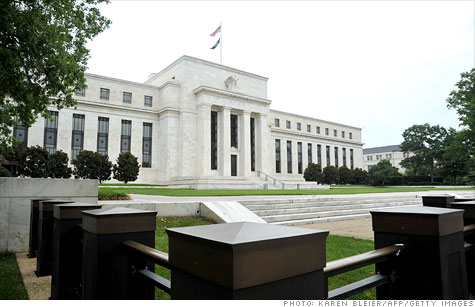Search News

Federal Reserve members comment on the central bank's current monetary policy tools.
NEW YORK (CNNMoney) -- "Potent" and "appropriate" were the words two Federal Reserve officials separately but simultaneously used to describe the central bank's tools to boost the economy Monday.
But they differed on which of those tools are effective and which could be detrimental.
Speaking before a room full of financiers in New York, President of the St. Louis Fed James Bullard cautioned the Fed against promising low interest rates over a set time period.
But at the same time he voiced support for the Fed's policies over the last two years, saying asset purchases are an effective and "potent tool."
About 200 miles away at the University of Maryland, Fed Governor Sarah Bloom Raskin used the same words to describe her support for the central bank's explicit guidelines on future interest rates.
"Forward guidance can be a potent tool of monetary policy," she said.
The two speeches capture an internal disagreement within the Fed, as to whether it's helpful or harmful for the central bank to set explicit guidelines for future monetary policy.
In August, the Fed surprised investors when it signaled its intention to keep interest rates exceptionally low until at least mid-2013.
Raskin said that holding rates near zero has kept the unemployment rate several percentage points lower than it would have otherwise been. "The Federal Reserve saved millions of jobs that would otherwise have been lost," she said.
She also believes that sending a clear message to investors about the Fed's future intentions, clears up uncertainty and is in itself an effective tool that can boost consumer and business spending.
Using the so-called "communication tool" is highly controversial though, with critics arguing it could lock the central bank into a policy regardless of how economic conditions change over the next two years.
Bullard is one such critic, who on Monday, argued that the Fed should instead give itself more wiggle room to re-adjust its policies on a meeting-by-meeting basis.
He points out that it can cause a credibility problem for the Fed, if policymakers suddenly find economic conditions have changed and they want to alter their course.
"There are problems on the credibility side with these kinds of promises," he said.
But Raskin and Bullard agree on other fronts, both calling the Fed's policies over the last two years "appropriate."
"In my judgment, the Federal Reserve's deployment of our policy tools has been completely appropriate in promoting maximum employment and price stability," Raskin said.
"Monetary policy is ultra loose right now, and appropriately so," Bullard said.
Since the recession, the Fed has engaged in two rounds of large-scale asset purchases, commonly known as quantitative easing, including most recently a $600 billion bond-buying program that ended in June.
And last week, the Fed announced a plan called Operation Twist, meant to shift $400 billion from short-term bonds into longer term securities.
All those polices are geared toward a common goal: reduce interest rates even further than their current historic lows, thereby making borrowing cheaper for businesses, consumers and homebuyers. ![]()
| Overnight Avg Rate | Latest | Change | Last Week |
|---|---|---|---|
| 30 yr fixed | 3.80% | 3.88% | |
| 15 yr fixed | 3.20% | 3.23% | |
| 5/1 ARM | 3.84% | 3.88% | |
| 30 yr refi | 3.82% | 3.93% | |
| 15 yr refi | 3.20% | 3.23% |
Today's featured rates:
| Latest Report | Next Update |
|---|---|
| Home prices | Aug 28 |
| Consumer confidence | Aug 28 |
| GDP | Aug 29 |
| Manufacturing (ISM) | Sept 4 |
| Jobs | Sept 7 |
| Inflation (CPI) | Sept 14 |
| Retail sales | Sept 14 |